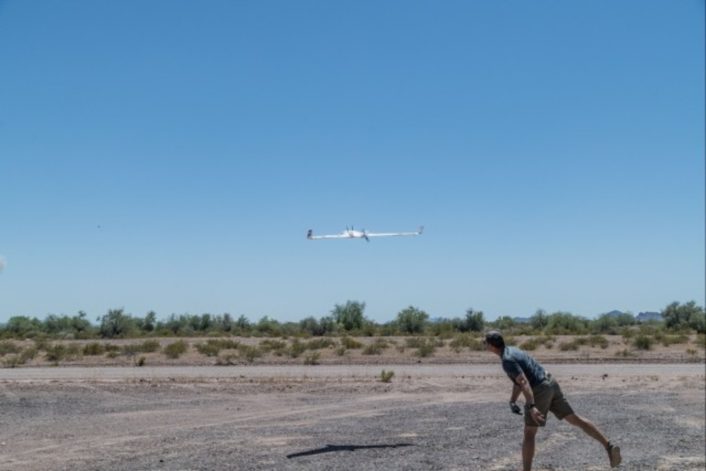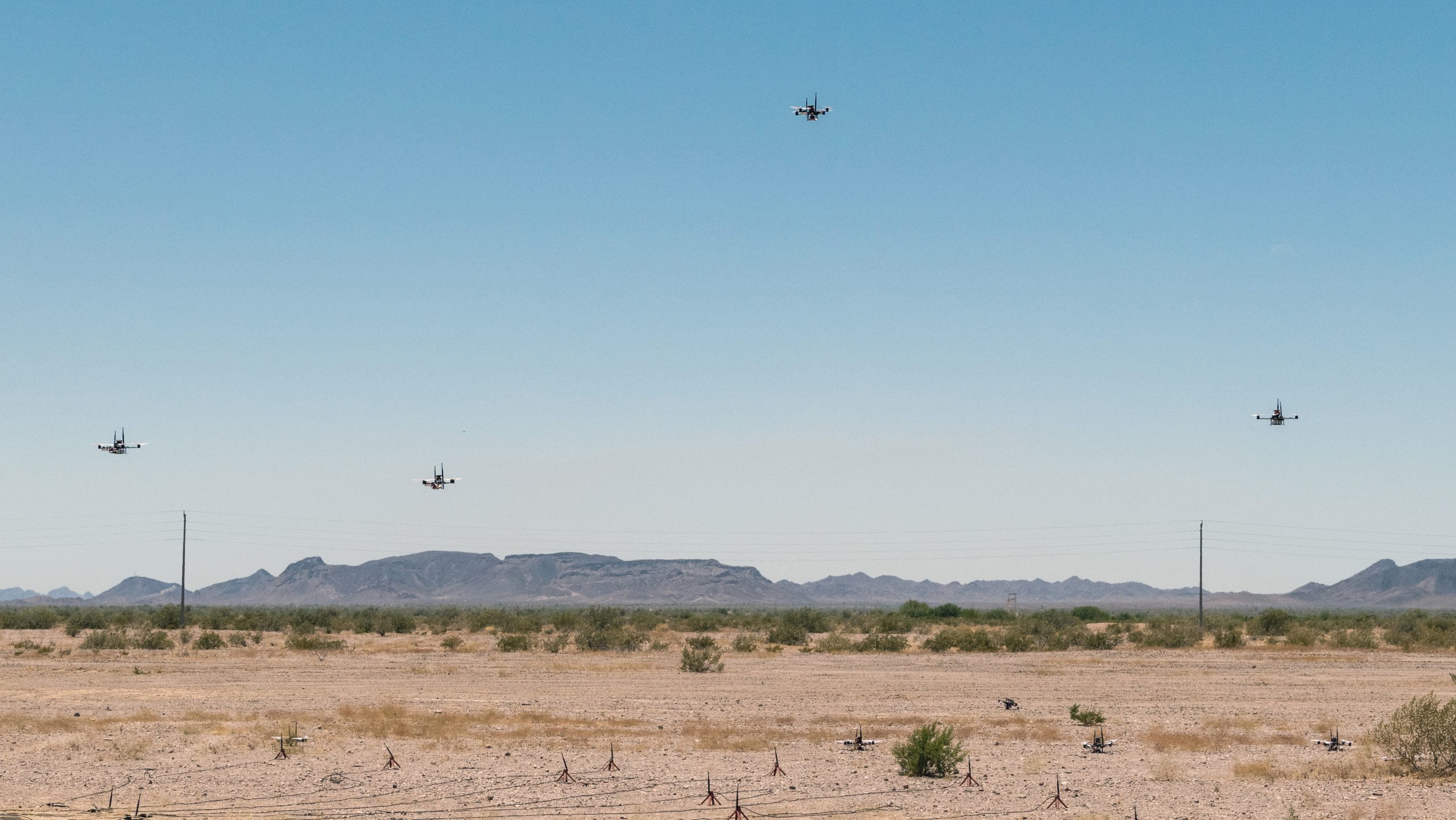The event was among the largest demonstrations using a mass sUAS attack scenario.
Taking a cue from the war in Ukraine and Chinese drone development capability, and the proliferation of commercial sUAS (Small Unmanned Aerial Systems), the US Army held its “most ambitious” test where companies demonstrated their Counter-sUAS systems. The statement said the event is believed to be “among the largest demonstrations using a mass sUAS attack scenario conducted to date.”
The test was the fifth such event at the YPG (Yuma Proving Ground) in Arizona, held over four weeks in Jun. 2024 and focused on “demonstrating systems capable of detecting and defeating swarms of sUAS,” according to a release.
The Army’s Joint C-sUAS Office down selected nine proposals to participate in the event, out of the 12 that were initially selected from “nearly 60 proposals.” The tests stood out in the intensity and volumes of attack on targets, where dozens of small UAVs descended on targets simultaneously and with the counter-drone systems by various firms deploying a combination of soft and hard kill measures to take down the swarms.
Forward Observers in AIT experienced a UAS/UAV capabilities demo from C-sUAS pilots. Capt. Ryaan Villagomez believes in the importance of driving change in the FA branch & brought this demo to his students. Our Soldiers continuously adapt & remain #CombatReady! ☝️ #ModernArmy pic.twitter.com/f15JSSmVRs
— US Army Fort Sill (@OfficialFtSill) February 16, 2024
Need to counter small drones
The battlefield in Ukraine has seen both the Ukrainian and Russian armies using small commercial off-the-shelf drones, most of them being FPV (First-Person View) UAVs for better and dextrous maneuvering, even in anti-infantry roles, changing the nature of ground troop-on-troops warfare. Strapped with explosives, besides being used to strike tanks, armored vehicles, artillery pieces, bunkers, fox holes, trench lines and machine gun posts, the UAVs are also used to hit individual soldiers on the battlefield.
Several videos show other overhead drones recording the attack/kamikaze drones going into bunkers, hitting a small detachment of troops or striking a lone soldier. In Ukraine’s case, the UAVs have even acquired a particular vitality, since they have become a substitute for gun artillery, owing to Kyiv’s loss of its Soviet-era guns and the shortage of Western howitzers.
While Russia has generally led in EW (Electronic Warfare), it too has periodically found itself taking heavy tactical losses as its industry was managing to keep up with the massive demand for drone jammers for units deployed across the frontline.
Kharkiv Oblast, Russian forces attempted to use a turtle tank to push into Ukrainian territory at the Vovchansk checkpoint.
The tank never made it into Ukraine, hitting a mine 1000 feet from the border inside of Russia, with Ukrainian FPV munitions finishing it off. pic.twitter.com/SOHIFJMDsC
— OSINTtechnical (@Osinttechnical) May 11, 2024
Meanwhile, videos emerging from China show both its military and civilian technology sector and defense firms demonstrating swarm drone technology. PLA (People’s Liberation Army) ground units are seen practicing flying FPV kamikaze drones through obstacles, as well as swarms of several dozen small UAVs being launched from tube launchers and maneuvering autonomously.
Although semi-autonomous and autonomous drone technology is still being refined, even the remotely operated ones pose tremendous threat to ground units, especially if several are being used against adversary troops in classic infantry battles. The side using FPV or even non-FPV small attack drones can significantly ease many attritional and time-consuming firefights by killing maximum troops and taking the load off own combatants and minimizing casualties in a mutually supporting role. Winning a series of such tactical ground engagements in a sector or a large frontline amounts to massive strategic advantages.
🇨🇳PLA FPV UAV operator practising hitting armoured vehicles (Type 59 tank) and acrobatic flight.
Very closely resemblance to the TTPs seen in 🇺🇦Ukraine, although the PLA already used these techniques before february 2022.
(Apologies, couldn’t find a higher quality video) pic.twitter.com/XzBkQDd4tj
— Jesus Roman (@jesusfroman) March 9, 2024
Drone jammers and counter-drone systems can disable only a singular or a few UAVs at a time by severing the radio control link or snapping the satellite navigation signal. Jamming many such control frequencies simultaneously would be a tall order. Counter-UAS systems usually have a combination of kinetic hard-kill measures like guns, non-kinetic soft kill approaches like RF (Radio Frequency) jamming, and non-kinetic hard-kill technologies comprising high-powered lasers or microwaves.
Largest C-sUAS test
The test at YPG saw the Army flying “50 targets in the air simultaneously,” according to Hi-Sing Silen, JCO’s test integration manager. “Those include rotary-wing, fixed-wing, fast-mover jet engines and propeller-driven group threes, all coming at you from almost 360 degrees,” said Silen. “It is as hard as it can be for a system trying to defend itself.”
“As far as I’m tracking, this is the first time the DOD has flown this many threat targets in the air at one time,” added Silen. “In other swarm demonstrations I have seen or heard about, you either have waves of incoming threats or they are coming one after another. In our scenario, you have 50 threats converging on your position at almost the same time.”

Different vendors used different methods to detect, track, identify and defeat threats. Among the solutions to defeat the threats were machine guns and rockets, high-powered microwave and electronic warfare systems. Some vendors provided kinetic interceptor drone-on-drone defeats, or combined aspects of other mechanisms, according to the statement.
“Some systems have small arms as part of their hard kill, but also have electronic warfare,” said Silen. “There is no one silver bullet in defending against threat UAS, especially when they are swarms. You have to have a layered defense to be able to fend off all the threats we are giving the systems.”
The testers watched for any anomalies and took extensive notes on each of the individual systems. The most recent demonstrations also attracted observers from counter-UAS programs who were hoping to gain insights that might be useful to other aspects of advancing technology to defend against sUAS threats. Seven U.S. government-sponsored systems also observed and collected data.













